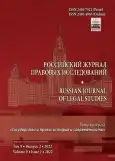The Structure of Judicial Reasoning in the Evaluation of Evidence in the Court Sentence
- 作者: Astafyev A.Y.1
-
隶属关系:
- Voronezh State University
- 期: 卷 9, 编号 2 (2022)
- 页面: 75-80
- 栏目: Criminal law and process
- URL: https://journals.rcsi.science/2410-7522/article/view/107431
- DOI: https://doi.org/10.17816/RJLS107431
- ID: 107431
如何引用文章
详细
This paper examines the essence of the court sentence as a legal document, the logical–compositional and substantive features of which are strictly regulated by law. It asks the question on the place of legal reasoning in the structure of the court sentence, and analyzes the methods used in the presentation and evaluation of evidence. In the analysis of the court verdict, the author uses some provisions of text linguistics and functional stylistics. It is argued that in the text of the sentence, argumentation is the main method of discourse used.
作者简介
Aleksey Astafyev
Voronezh State University
编辑信件的主要联系方式.
Email: woltgam@rambler.ru
candidate of the law
俄罗斯联邦, Voronezh参考
- Trosheva TD. Formation of reasoning in the development of the scientific style of the Russian literary language of the 18th – 20th centuries: in comparison with other functional varieties: author. dis. ... doct. philol. Sciences. Perm, 2000. 38 p. (In Russ.).
- Hamaganova VM. The functioning of stating texts in the structure of a text of the "Reasoning" type. Scientific notes of ZabGSPU. Series: Philology, History, Oriental Studies. 2010;(3):142–149. (In Russ.).
- Omelchenko LN. About syncretism in the system of functional-semantic types of speech. Bulletin of BSU. 2013;(10):55–58. (In Russ.).
- Eremina IA. Reasoning as a transitional type of speech between monologue and dialogue: based on the material of the English language: author. dis. ... cand. philol. sciences. Moscow, 2004. 20 p. (In Russ.).
- Strogovich MS. Doctrine of material truth in criminal proceedings. Moscow; Leningrad, 1947. 276 p. (In Russ.).
补充文件







